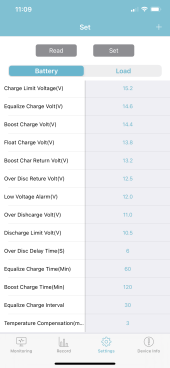vashkoproimage
New Member
- Joined
- Apr 6, 2022
- Messages
- 57
Best settings for Renogy charge controller with AGM battery setup. Currently using a Renogy 40 amp controller with 12v AGM setup. Battery's are Eaton pwhr12540w4fr battery's. Some people say not to charge AGM over 14.4 and some say to over charge them. What do you guys think?
Settings I am able to adjust in USER mode are in the image.
Renogy 40 amp charge controller
6 100 Watt Solar panels
6 AGM 135ah battery's
3000 Watt Renogy Inverter
Settings I am able to adjust in USER mode are in the image.
Renogy 40 amp charge controller
6 100 Watt Solar panels
6 AGM 135ah battery's
3000 Watt Renogy Inverter



